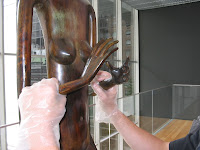 Nearly a week after our Met touch tour, my blind friend and I took a touch tour of the Museum of Modern Art (MoMA).
Nearly a week after our Met touch tour, my blind friend and I took a touch tour of the Museum of Modern Art (MoMA).MoMA organized the tour on a day when the museum is closed to the public. We were accompanied by our guide (Paula), an observer from Spain who is a museum specialist (Lorda), and a museum guard who did not introduce himself.
Paula has a disability, and she and my friend quickly shared an understanding about their differences.
The tour began in the outdoor sculpture garden. We put on very thin gloves and began feeling a series of reliefs by Matisse which depict a woman's back. The reliefs are arranged in order chronologically. The first sculpture was completed in 1909 and the last one was made in 1931. My friend identified the various body parts and compared them from sculpture to sculpture. He noticed that the features changed dramatically in the later works. As the features became more abstract, he had difficulty identifying them as body parts.
This difficulty with abstract sculpture extended to pieces by Picasso and Boccioni. My friend could feel the features of a goat in Picasso's "She Goat" but he didn't appreciate the artist's use of mixed materials. The unusual components interfered with his understanding of the whole form.
He had a better experience with Giacometti's works. The texture of "Standing Woman" was unusual, but the form was easily recognizable.
Lorda pointed out that Giacometti was influenced by Egyptian art, and indicated that the feet were handled in a manner similar to ancient sculptures. Since we had recently taken a touch tour of the Met's Egyptian wing, my friend was able to compare the use of negative space in Giacometti's piece to the ancient Egyptian sculptures. He could also sense compositional similarities in the works.

While it was sometimes difficult to know what the artist tried to depict by feeling shapes, my friend had an uncanny ability to sense the composition of material. He could tell from one touch that a Barnett Newman sculpture was weathered and rusted.
Franz West's sculptures were probably the abstract pieces with the most appeal to my friend. He and I both taught kindergarten. When Paula and I described the works by comparing them to brightly colored bent pipe cleaners, my friend's face became animated. He could easily picture the pieces in his mind. As he stood inside an orange sculpture composed of rounded bands, he surprised us by declaring that he felt as if he were inside of a pumpkin. The word does resemble a pumpkin.
My friend also enjoyed Giacometti's sculpture "Hands Holding the Void." The features were more easily recognizable to him. Even an unusual feature, such as a face composed of an African mask, was discerned readily.
We talked about what the hands may have held. He and Lordes compared the composition to depictions of the Virgin Mary. Perhaps the hands held an infant Jesus who was not shown.
In the context of our project, the most striking feature of the sculpture was the similarity between its hands and those of my friend. Both appeared to be exploring space in an effort to gain greater understanding.



